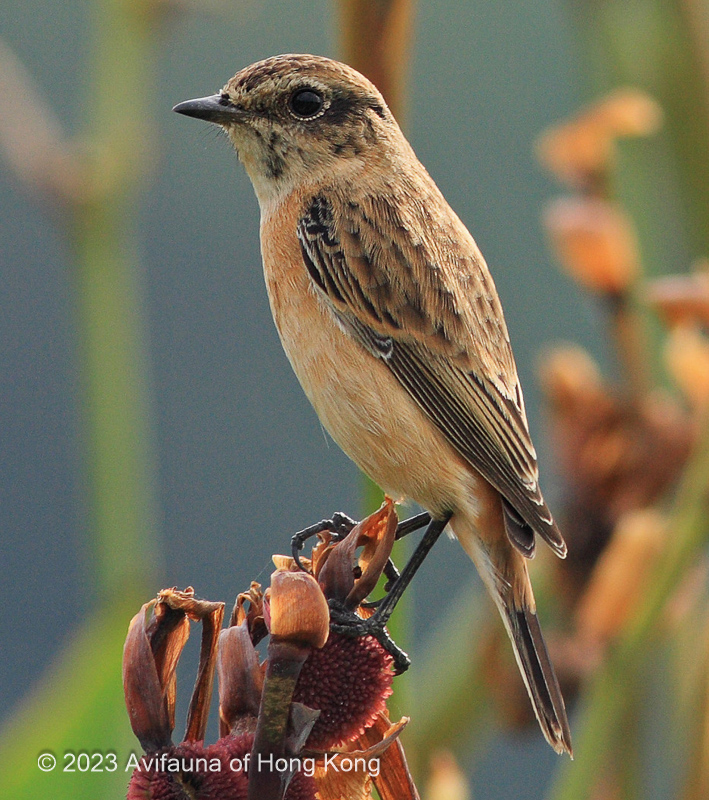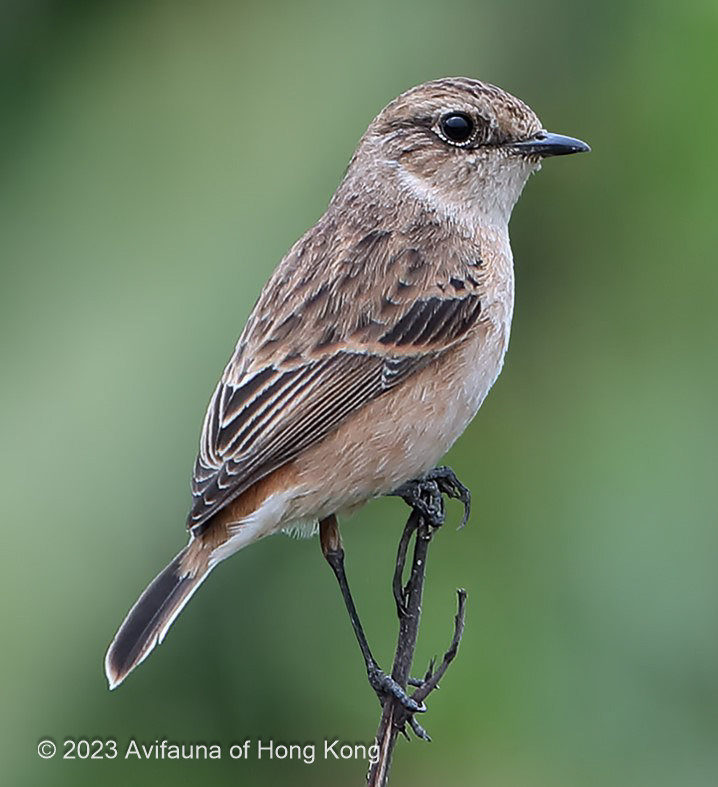Amur Stonechat Saxicola stejnegeri 黑喉石䳭
Category I. Common passage migrant and winter visitor to open country areas.
IDENTIFICATION

Dec. 2018, Kenneth Lam. Adult male.
12-13 cm. Adult male in breeding plumage has a black head, blackish brown upperparts with a white wing patch (not always visible) and a white rump. Has white side to neck, buffish-orange breast, white belly and undertail coverts. Becomes darker above as browner feather fringes wear off during winter.

Nov. 2008, FUNG Hong Shing. Adult male.
Fresh adult males in autumn after complete post-breeding moult have browner crown and upperparts with dark mottling, a rufous rump, blackish on face, chin and throat. The buff fringes to the upperpart feathers wear away during the winter.

Nov. 2020, Michelle and Peter Wong.
Females and first-autumn birds have brown upperparts, indistinct dark streaks on the crown, a variable buffish supercilium, pale throat, pale rufous breast and flanks and a small or indistinct white wing patch. Rump and uppertail coverts are rufous-orange.
VOCALISATIONS
The usual call is a somewhat grating ‘chak’.
Sometimes interspersed with a moderately high-pitched and short ‘hweet’, very similar in frequency to Daurian Redstart but with a more obvious terminal fall in pitch.
DISTRIBUTION & HABITAT PREFERENCE
Common in lowland open country habitats such as dry agriculture, village-edge areas, waste ground, open-canopy shrub, shrub/grassland, fish ponds and reed marsh, particularly in the northwest New Territories.
It was recorded in 10.3% of 1km squares during the 2001-05 winter atlas, but this reduced to 6.3% in the 2016-19 survey, although the area of occurrence was broadly similar in the two periods apart from a greater decline in the Tin Shui Wai area no doubt due to the expansion of development into land set aside for residential estates in this area.
OCCURRENCE
Common passage migrant and winter visitor, extreme dates are 17 August and 9 May. Rare in August and scarce in September, peak numbers (presumed to be mainly migrants) occur throughout October while somewhat lower numbers in November are presumed to comprise both passage migrants and arriving winter visitors (Figure 1). The number of birds remains relatively stable from November to January, after when there is a gradual decrease in numbers to the first week of March; a rise in numbers during the rest of March presumably consists of passage birds moving north. It is scarce after mid-April and rare in early May. This pattern of occurrence appears little changed since 1958.
A male was photographed on Tai Mo Shan on 14 June 2019. While this is regarded as ex-captive, there is a possibility of natural occurrence.
The highest counts on record are 60 on 6 November 1993 at Long Valley and 53 at Tin Shui Wai on 12 October 1994. Counts since 1999 are generally lower: 50 at Hoo Hok Wai on 2 January 2001 (now regarded as an unusually high winter count), and 33 at Long Valley on 4 October 2008 are the highest. This reduction in peak counts, along with the fact that it was only observed in 6.3% of squares in the winter atlas 2016-19 compared with 10.3% of squares in 2001-05, suggests that overall numbers have declined in HK.
Amur Stonechat is regularly trapped in the reedbed at Mai Po where the pattern of occurrence indicates strong autumn passage peaking somewhat earlier than field records in the first half of October and a sharp fall in numbers in the second week of November (Figure 2). Small numbers remain in this habitat in the winter and there is a weak passage from mid-March to the third week of April.
Intra-seasonal re-traps are common and show that some individuals are long-staying: a bird first trapped on 4 October 2012 was retrapped five times during that winter, the last being on 23 March 2013. Re-traps between seasons are infrequent but do occur. Of particular note was a bird initially ringed on 22 November 2011 that was retrapped 2011/12, 2012/13, and three times in the 2014, the final date being 19 December 2014.
Historically, it was noted by previous authors as a common winter visitor (Swinhoe 1861, Kershaw 1904, Vaughan and Jones 1913, Herklots 1953).
BEHAVIOUR, FORAGING & DIET
Perches prominently on bushes, fences and overhead wires. Often flicks wings and tail. At least partly territorial in autumn and winter, and two males were noted in song at Long Valley on 23 October 2000.
Little information regarding diet but apparently feeds on small invertebrates. Hutson (1931) noted that it takes up a “commanding position, a bush, hedge or some other elevation upon which to perch and watch for its prey. From its vantage point … the Stonechat darts down in shrike-fashion upon insects on the ground.”
RANGE & SYSTEMATICS
Monotypic. Previously treated as a subspecies of Common Stonechat S. torquatus.
Breeds in central and east Siberia, north and east Mongolia, north and north central China (Heilongjiang, southeast Inner Mongolia and north Hebei), east Russia, Korea and Japan. It winters in north India, Bhutan, Myanmar, south China, south and central Japan, and southeast Asia south to Malaysia and Singapore (Clement and Rose 2015, Liu and Chen 2020).
CONSERVATION STATUS
IUCN: Least Concern. Population trend stable.
Figure 1.

Figure 2.

Clement, P. and C. Rose (2015). Robins and Chats. Christopher Helm, London.
Hutson, H. P. W. (1931). The birds of Hong Kong. Part VII. Sub-family Saxicolinae (Chats). Hong Kong Naturalist 2: 151-152.
Herklots, G. A. C. (1953). Hong Kong Birds. South China Morning Post, Hong Kong.
Kershaw. J. C. (1904). List of birds of the Quangtung Coast, China. Ibis 1904: 235-248.
Swinhoe, R. (1861). Notes on the ornithology of Hong Kong, Macao and Canton, made during the latter end of February, March, April and the beginning of May 1860. Ibis 1861: 23-57.
Vaughan, R. E. and K. H. Jones (1913). The birds of Hong Kong, Macao and the West River or Si Kiang in South-East China, with special reference to their nidification and seasonal movements. Ibis 1913: 17-76, 163-201, 351-384.
Liu, Y. and Y. H. Chen (2020). The CNG Field Guide to the Birds of China (in Chinese). Hunan Science and Technology Publication House.

